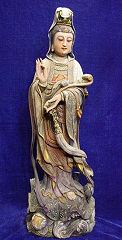
Kwan Yin in Asian Art
For many centuries, Kwan Yin (also spelled Quan Yin) has represented the great ideal of Mahayana Buddhism in her role as "bodhisattva" (Chinese: p'u sa) - "which means a being of Bodhi, or enlightenment" whose destiny is to become a Buddha but has foregone the bliss of Nirvana and made a vow to help mankind.
Quan Yin carries the Goddess and Divine Mother aspect of Buddhism, the same Goddess and Divine energy carried by the Virgin Mary in Christianity. She is also synonymous with mercy and compassion. In the Egyptian mysteries it is carried by Isis. In Hinduism it is carried by Shakti, wife of Vishnu, by Parvarti, wife of Shiva, by Radha, wife of Krishna, and by Sita, wife of Rama.
Quan Yin's name is a translation of the Sanskrit name of her chief progenitor which is Avalokitesvara, also known as Avalokita. In its proper form it is Kuanshih Yin, which means "She who harkens to the cries of the world".
Buddhist mythology tells of Avalokitesvara's being born from a ray of light that sprang from Amitabha Buddha's right eye. He immediately said, "Om Mane Padme Hum". This is one of the mantras by which he can be invoked in Buddhist tradition. Om Mani Padme Hum can not really be translated into a simple phrase or even a few sentences. Tibetan Buddhists believe that saying the mantra (prayer), Om Mani Padme Hum, out loud or silently to oneself, invokes the powerful benevolent attention and blessings of Quan Yin, the embodiment of compassion.
In India Avalokitesvara is usually portrayed as a handsome young prince with the Buddha nestled in his crown. Avalokitesvara came to be known by most Tibetans as Buddha's earthly representation and as chief guardian of the dharma (doctrine) until the advent of Maitreya Buddha. Some feel that the current Dali Lama is an incarnation of Avalokitesvara.
Closeups of the statues on this page and every sculpture in the Villa Del Prado Light of Asia Collection can be found on the main page. |
 In Korea and China she is called Quan Yin (also spelled Kwan Yin) . In Japan, she is called Kannon. She is a celestial bodhisattva and an ascended master. One of her jobs in the celestial spheres is to sit on the board of the Lord of Karma.
In Korea and China she is called Quan Yin (also spelled Kwan Yin) . In Japan, she is called Kannon. She is a celestial bodhisattva and an ascended master. One of her jobs in the celestial spheres is to sit on the board of the Lord of Karma.
 It is thought that the female form of Avalokitesvara, Quan Yin, originated in the twelfth or thirteenth century in both China and Japan. Avalokitesvara and Quan Yin or Kannon are embodiments of compassion. In female form she is roughly equivalent to Green Tara in Tibetan Buddhism, who is considered to be the goddess of universal compassion who represents virtuous and enlightened activity.
It is thought that the female form of Avalokitesvara, Quan Yin, originated in the twelfth or thirteenth century in both China and Japan. Avalokitesvara and Quan Yin or Kannon are embodiments of compassion. In female form she is roughly equivalent to Green Tara in Tibetan Buddhism, who is considered to be the goddess of universal compassion who represents virtuous and enlightened activity.
